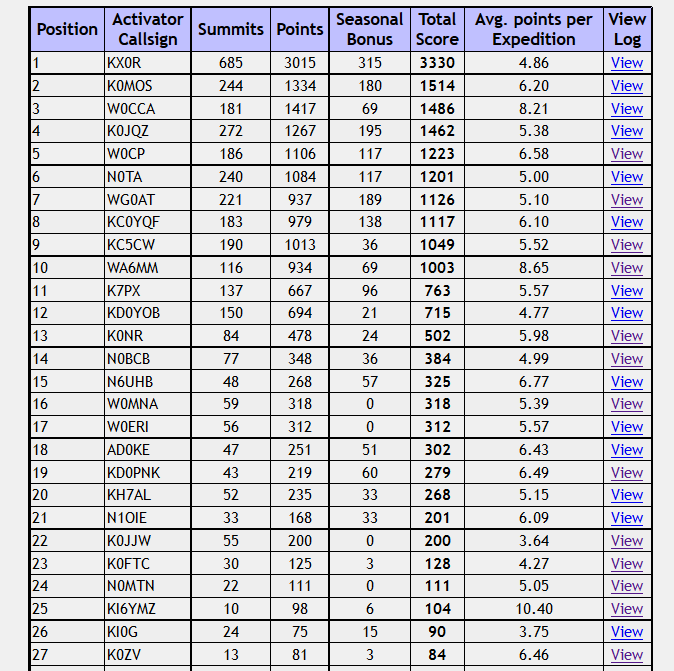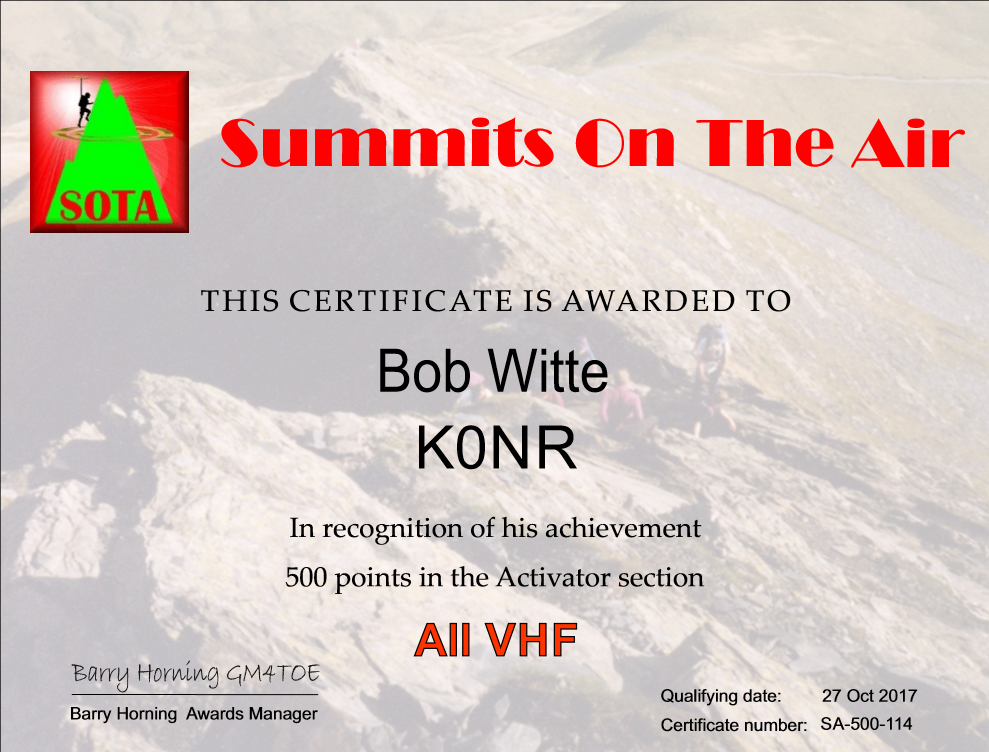 Big shoes to fill!
Big shoes to fill!
The 2018 ARRL International Grid Chase follows on the heels of the successful Centennial operating event and the even more successful National Parks On The Air operating event.
The idea is work as many different Maindenhead grid squares as you can, on any band (expect for 60 Meters) using any mode. Contacts made through satellites will count; but contacts made through earthbound repeaters will not.
So how will all these contacts be kept track of? Through Logbook Of The World, of course! So it is imperative that you have an LOTW account as well as the station you are working. When you both upload your logs to LOTW; and you get a match, you get credit for a valid QSO for the ARRL IGC.
While total cumulative results will be posted at the end of the year, the clock will "reset" so to speak, at the beginning of each month. So each month of 2018 will be like a new operating event; or competition. (I hate to use the word "contest", as we all know that contests are forbidden on the WARC bands.)
Should you not know your Maidenhead Grid Square locator, it's easy to find out. You can either look yourself up on QRZ.com, or go to http://www.levinecentral.com/ham/grid_square.php. What's interesting about these two methods is that you might get different results. QRZ tells me that my grid square is FN20to and Levine Central tells me that it's FN20so. No matter ...... for the purposes of the ARRL IGC, you'll only need the first four places. In addition, exchanging the grid square during the QSO is not required. LOTW will keep track of that. I suppose that for those who will go out and activate rare grids, there will be some provision made for identifying what grid square was operated from when uploading contacts into LOTW.
Will this be as successful as the last two events? That remains to be seen. The Centennial Event was huge success and NPOTA was a monster success. In any event, kudos to the ARRL for continuing to come up with ideas to keep Amateur Radio life a little on the spicier side.
72 de Larry W2LJ
QRP - When you care to send the very least!
Larry Makoski, W2LJ, is a regular contributor to AmateurRadio.com and writes from New Jersey, USA. Contact him at w2lj@arrl.net.
 ICQ Podcast Episode 253 – Using PSK31
ICQ Podcast Episode 253 – Using PSK31
In this episode, Martin is joined by Leslie Butterfield G0CIB, Edmund Spicer M0MNG, and Bill Barnes N3JIX to discuss the latest Amateur / Ham Radio news. Colin M6BOY rounds up the news in brief, and this episode’s feature is Using PSK31.
We would like to thank our monthly and annual subscription donors for keeping the podcast advert free. To donate, please visit - http://www.icqpodcast.com/donate
- 430-440 MHz Medical Capsule Endoscopy Application
- Canadian's Tiny LF Hop
- VHF Manager Handbook Version 8.00
- Sweden Releases Amateur Radio Training Guide
- Tin whisker
- New Digital Modes Changing Complexion of Bands and Ham Radio?
- Hams in Argentina get 5 MHz and 472 kHz bands
- Bletchley Park 'listener' Passes
- Free Back Issues of Ham Radio Horizons
Colin Butler, M6BOY, is the host of the ICQ Podcast, a weekly radio show about Amateur Radio. Contact him at info@icqpodcast.com.
 AmateurLogic 111: Some Fella with Blue Teeth
AmateurLogic 111: Some Fella with Blue Teeth
AmateurLogic.TV Episode 111 is now available for download.
Tommy builds a dummy load with a scope sample port. Peter controls an Arduino from his phone with Bluetooth. George experiments with LED current draw. Emile’s got a new tuner.
1:15:01
George Thomas, W5JDX, is co-host of AmateurLogic.TV, an original amateur radio video program hosted by George Thomas (W5JDX), Tommy Martin (N5ZNO), Peter Berrett (VK3PB), and Emile Diodene (KE5QKR). Contact him at george@amateurlogic.tv.
 Amateur Radio Weekly – Issue 180
Amateur Radio Weekly – Issue 180
The ARRL International Grid Chase
The year-long event hopes to build on the success of the highly successful 2016 National Parks on the Air. The objective is to work stations on any band in as many different Maidenhead grid squares as possible.
ARRL
160m FT8 – The end of an era?
If you follow any of the numerous ham radio-related discussion groups then you know that every once in awhile a thread pops up that triggers some extended and often heated chat.
AmateurRadio.com
Become an APRS Weather Alert Station
noaacap uses the NOAA CAP (Common Alerting) protocol and the Atom feeds published by the National Weather Service. Installation is quick and simple if you have a running aprx system.
K2DLS
Flying with lithium batteries
As I made my way through the security line, the battery was naturally flagged for further inspection. Eventually the security folks cleared it, pending approval from the airline.
WB4RFQ
6m J-Pole antenna
The antenna is manufactured from square aluminium tube, welded and with a perspex spacer at the top of the J.
marxy’s musing on technology
Encounters with the dead
All this has gotten me to thinking about how I’d like my websites to be handled once I become an SK.
KB6NU
FA-VA4 antenna analyzer kit
The case is a brushed aluminum with attention to detail such as counter sunk screws for securing case, the LCD and buttons lined up perfectly and a nice touch was not having stick on rubber feet.
VE3WDM
Build a lightning detector
Basic lightning detector schematic.
AWSH.ORG
The Spirit of Knoxville
The Spirit of Knoxville is a high-altitude balloon project run by amateur scientists and University of Tennessee students, with the ultimate goal of successfully sending an unmanned balloon across the Atlantic Ocean.
Wikipedia
How the integrated circuit came to be
It may surprise you that the microchip that we all know and love today was far from an obvious idea.
Hack A Day
Cape San Blas Florida Lighthouse activation
Saturday, Nov. 11, 1500 UTC to 1900 UTC.
Southgate
Video
First look: New Ailunce HD1 dual band DMR radio
This brand new high power dual band DMR radio made specifically for amateurs is about to be released.
YouTube
DX Monster antenna
Even with the current solar cycle as it is, I am making more DX contacts now than I ever have over 25 years. Part of my luck must be given to the new digital mode called FT8, but I am also of the mind that my antenna is doing a fine job.
Radio Hobbyist
Amateur Radio Weekly is curated by Cale Mooth K4HCK. Sign up free to receive ham radio's most relevant news, projects, technology and events by e-mail each week at http://www.hamweekly.com.
 Colorado (W0C) SOTA Activators
Colorado (W0C) SOTA Activators
Here’s the SOTA activator scores for Colorado (W0C). I have to admit that I like checking this to see how everyone is doing. Some of it is friendly competition but mostly its enjoying the accomplishments of my fellow SOTA enthusiasts.
 We’ve got 10 “Mountain Goats” in Colorado now, with 1000 or more points. Carey, KX0R just never stops activating. It seems like he is out there on a summit every day. My friend Brad WA6MM just made “Mountain Goat,” by activating only Colorado summits, never repeating any, with many difficult climbs. Note that his average points per expedition is 8.65, higher than any of the other MGs. (W0CCA comes close at 8.21) Congratulations, Brad!
We’ve got 10 “Mountain Goats” in Colorado now, with 1000 or more points. Carey, KX0R just never stops activating. It seems like he is out there on a summit every day. My friend Brad WA6MM just made “Mountain Goat,” by activating only Colorado summits, never repeating any, with many difficult climbs. Note that his average points per expedition is 8.65, higher than any of the other MGs. (W0CCA comes close at 8.21) Congratulations, Brad!
 It looks like K7PX and KD0YOB are next in line for Mountain Goat, while I am still a ways back. My hiking partner Joyce/K0JJW is coming on strong, having accumulated 200 points. I just cleared “half a Mountain Goat” at 500 points, so I requested a certificate for that accomplishment. At my current rate of progress, I am about 2 years away from Mountain Goat. I keep telling myself to be patient, keep at it and (most of all) enjoy the journey.
It looks like K7PX and KD0YOB are next in line for Mountain Goat, while I am still a ways back. My hiking partner Joyce/K0JJW is coming on strong, having accumulated 200 points. I just cleared “half a Mountain Goat” at 500 points, so I requested a certificate for that accomplishment. At my current rate of progress, I am about 2 years away from Mountain Goat. I keep telling myself to be patient, keep at it and (most of all) enjoy the journey.
73, Bob K0NR
The post Colorado (W0C) SOTA Activators appeared first on The KØNR Radio Site.
Bob Witte, KØNR, is a regular contributor to AmateurRadio.com and writes from Colorado, USA. Contact him at bob@k0nr.com.
 Complete Version: On How NCIS Maligned the Amateur Radio Service
Complete Version: On How NCIS Maligned the Amateur Radio Service
Some of you wanted to see the complete version, uncut, of this video in which I discuss the differences between CB and the Amateur Radio Service. This is in response to the recent episode in which the NCIS writers missed a great opportunity to discover the vibrant reality of the current amateur radio service in the United States of America.
The previous version of the video was prematurely cut short by just over three minutes. This version includes that ending. I also remove some of the low-end rumblings from the vehicle. This version should sound a little bit less annoying. Hopefully, the quality of the video is sharper, as well. This version was edited by Adobe Premiere CC 2017.
I appreciate the many comments, views, and shares. Please subscribe, too!
73 from Omaha!
Visit, subscribe: NW7US Radio Communications and Propagation YouTube Channel
 The latest 1/4W 1% resistor deals
The latest 1/4W 1% resistor deals
Resistor deals just get better!
Last time I looked over selling websites it was a 2000 deal, but I have now found a couple of 2500 1/4W 1% metal film Res bargains.
First one is the Chinese site Banggood @ £7.42 (US $9.51) plus a 12% voucher popped up, which you have to bop in at the time of placing the order, taking the price down to a penny pinching £6.53
https://www.banggood.com/2500Pcs-1-14W-0_25W-Metal-Film-Resistor-50-Values-Assortment-Kit-110M-Range-p-1079638.html?rmmds=category&cur_warehouse=CN
I then run the details through ebay and a similar package came out at £6.99 ($9.18):
https://www.ebay.co.uk/itm/2500-Pcs-1-4w-1-Metal-Film-Resistor-Kit-50-Values-Assortment-Pack-Mix-Selection/382146134127?hash=item58f9af406f:g:OT8AAOSwyWZZVqNd
* Please note I have no connection with either company, I just do this for service for you Hams and constructors. £ to $ conversion is done at the time, and can change with currency fluctuations.
Good luck!
Steve, G1KQH, is a regular contributor to AmateurRadio.com and writes from England. Contact him at g1kqh@arrl.net.














